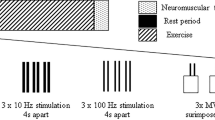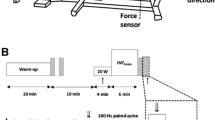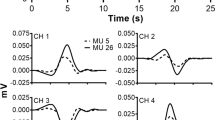Abstract
The kinetics of the torque-velocity (T-ω) relationship after aerobic exercise was studied to assess the effect of fatigue on the contractile properties of muscle. A group of 13 subjects exercised until fatigued on a cycle ergometer, at an intensity which corresponded to 60% of their maximal aerobic power for 50 min (MAP60%); ten subjects exercised until fatigued at 80% of their maximal aerobic power for 15 min (MAP80%). Of the subjects 7 exercised at both intensities with at least a 1-week interval between sessions. Pedalling rate was set at 60 rpm. The T-ω relationship was determined from the velocity data collected during all-out sprints against a 19 N · m braking torque on the same ergometer, according to a method proposed previously. Maximal theoretical velocity (ω0) and maximal theoretical torque (T 0) were estimated by extrapolation of the linear T-ω relationship. Maximal power (P max) was calculated from the values of T 0 and ω0 (P max = 0.25 ω0 T 0). The T-ω relationships were determined before, immediately after and 5 and 10 min after the aerobic exercise. The kinetics of ω0, T 0 and P max was assumed to express the effects of fatigue on the muscle contractile properties (maximal shortening velocity, maximal muscle strength and maximal power). Immediately after exercise at MAP60% a 7.8% decrease in T 0 and 8.8% decrease in P max was seen while the decrease in ω0 was nonsignificant, which suggested that P max decreased in the main because of a loss in maximal muscle strength. In contrast, MAP80% induced a 8.1% decrease in ω0 and 12.8% decrease in P max while the decrease in T 0 was nonsignificant, which suggested that the main cause of the decrease in P max was probably a slowing of maximal shortening velocity. The short recovery time of the T-ω relationship suggests that the causes of the decrease of torque and velocity are processes which recover rapidly.
Similar content being viewed by others
Author information
Authors and Affiliations
Additional information
Accepted: 25 November 1996
Rights and permissions
About this article
Cite this article
Buttelli, O., Vandewalle, H., Jouanin, J. et al. Effects of aerobic exercise on the torque-velocity relationship in cycling. Eur J Appl Physiol 75, 499–503 (1997). https://doi.org/10.1007/s004210050195
Issue Date:
DOI: https://doi.org/10.1007/s004210050195




